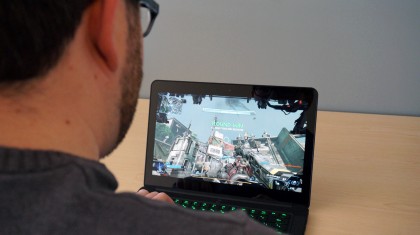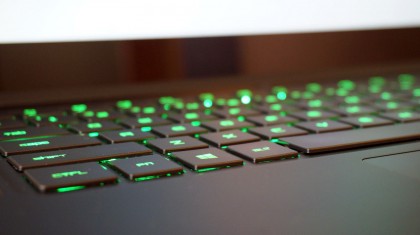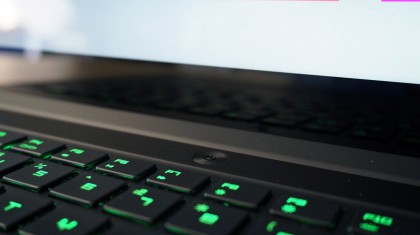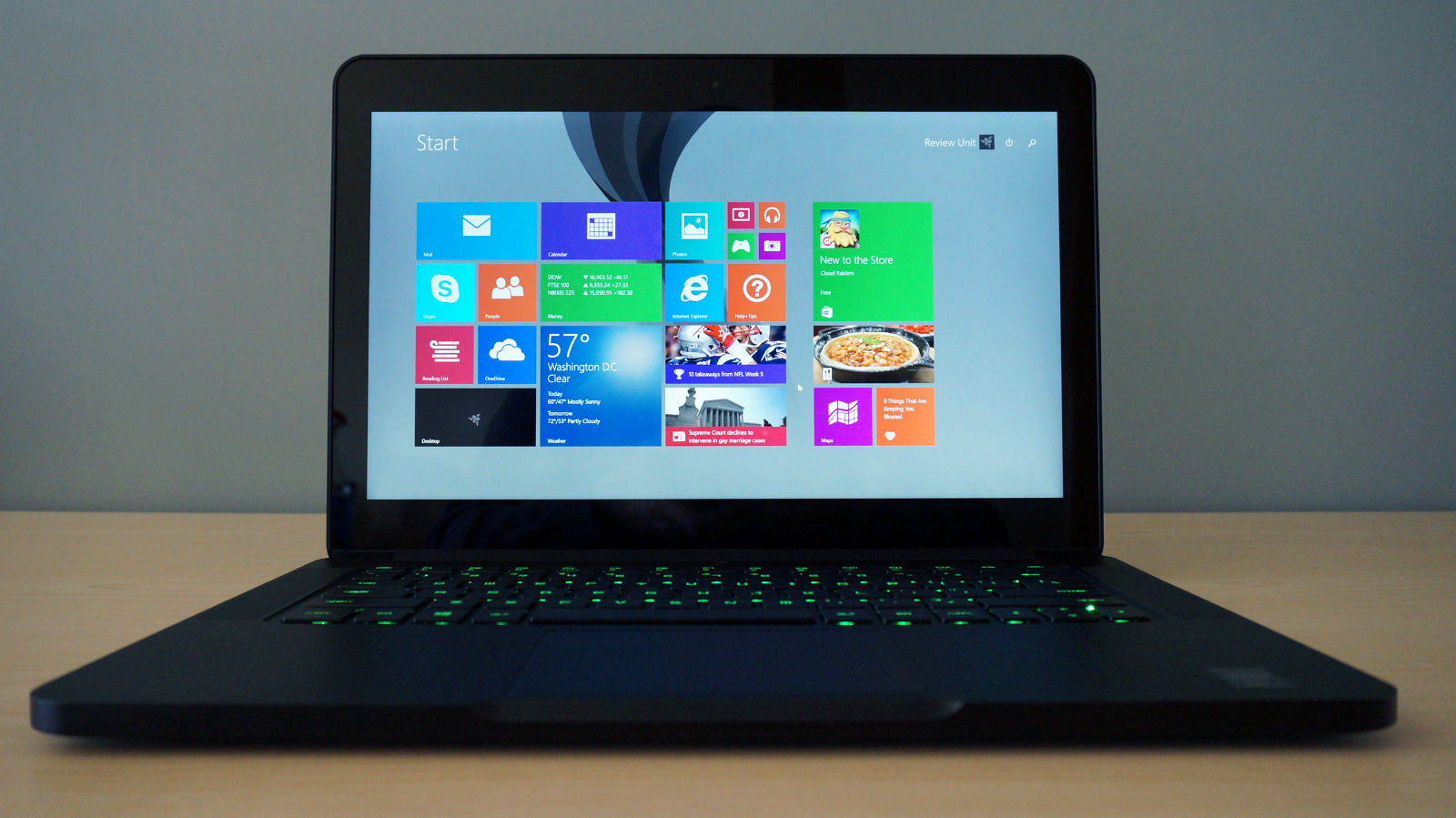Why you can trust TechRadar
This gaming laptop might come in a fancy package, but don't go for a second thinking that it's all looks and no substance. Based on the synthetic tests I ran on this machine alone, this thing is a monster.
Benchmarks
- 3DMark: Ice Storm: 52,610; Cloud Gate: 15,255; Fire Strike: 4,207
- Cinebench CPU: 585 points; Graphics: 90.92 fps
- PCMark 8 Home: 2,619 points
- PCMark 8 Battery Life: 2 hours, 40 minutes
- Bioshock Infinite (1080p, Ultra): 52 fps; (1080p, Low): 150 fps
- Metro: Last Light (1080p, Ultra): 18 fps; (1080p, Low): 71 fps
On all the synthetic tests, the new Razer Blade fought toe-to-toe with the MSI GS60 Ghost Pro 3K and Gigabyte P35W v2, reporting scores within points either way. (At least on these benchmarks, the extra RAM didn't do those rigs much good.)

While those Metro: Last Light numbers look atrocious, keep in mind that this game chews up most all mobile GPUs. That said, I would expect to be able play just about any PC game that lands this year or next at 1,920 x 1,080 resolution and high settings. Beyond full HD, however, is where you might run into some problems.
The gaming life beyond HD
Phrases like "1440p" and "4K" chart the next frontier in PC gaming. On the desktop, we're already there, though for far more than most are willing to pay for even an Xbox One or PS4. On laptops, however hard the GPU makers and notebook vendors try, we're just not there yet – but we're awfully, terribly close.
Take my time with Titanfall at 3,200 x 1,800 on high settings (with double buffered vertical-sync and 2x MSAA at about 30% draw distance), for instance. Using Fraps on a five minute run during a live match, the Blade managed a perfectly playable 32 frames per second on average. That's fine for one of 2014's premiere shooters, but what about 2015?
I'm not confident that the GTX 870M, as powerful as it is, will be able to reliably play more demanding games like, say, Dragon Age: Inquisition or even the recent Alien: Isolation at this resolution and similar settings. Sure, 1080p should be no problem, but an admission like that begs the question: why bother with such a sharp screen then?

Plenty of pixels to go around, but where to?
There's no denying that the IGZO IPS panel is a beauty to behold. Text and images look astounding, with nearly nonexistent viewing angles, and games look especially smooth. I barely noticed shifts in frame rate while blowing up giant robots at native resolution, likely thanks in part to the IGZO's enhanced response time.
Sign up for breaking news, reviews, opinion, top tech deals, and more.
If you're able to find QHD+ video online, much less stream it at a respectable clip (that's where AC Wi-Fi comes in), I'm sure that it will look simply stunning on this screen. But that's just the problem: unless you're a frequent traveler, how many movies are you going to watch on a 14-inch screen? If you're in the market for such a premium laptop, chances are you already have an excellent HDTV, if not a 4K TV.
And if gaming at acceptable frame rates at such a sharp resolution is going to be a challenge with this hardware as we enter 2015, where does that leave this absurdly attractive piece of machinery? Perhaps I'm being too harsh on such a fantastically-designed device, but the asking price in the presence of such value-packed machines deserves some extra scrutiny.

Bringing the heat – literally
Razer made great efforts to better move heat around and out of its flagship gaming laptop, from localized heating, custom designed pipes and diamond-cut vents to better cool air as it enters the internals while hot air exits. The company even coded a smart cooling system into the laptop's BIOS.
It's crystal clear that Razer knows that gaming laptops, especially ones this thin, have trouble with heat, and its engineering teams are on it. It's too bad, then, that heat is still an enormous issue with the new Razer Blade. After just a few minutes in any 3D game, any area above the middle row of letter keys was hot to the touch, with the region between the hinge and keyboard deck being painfully so.
I say this with almost all gaming laptops, but I'll add an exclamation point to this disclaimer: do not play games with this thing on your lap! That said, the Blade nary makes noise above a whisper while playing games – just consider buying one of those laptop coolers.

A battery befitting of its size
Call me spoiled by the forbidden fruit, but with laptops this thin and light, I've come to expect longevity to match. Otherwise, what's the point of a notebook designed to better fit in my bag if it can't last for the length of my travels? Razer hasn't broken any records, but it's managed to impress in the battery department.
The more intense PCMark 8 battery test didn't do the Blade any favors with a 2 hours and 40 minutes recorded time, but my arguably lighter (and more realistic) anecdotal testing saw much better lasting power. While no 13-inch MacBook Air, the Razer Blade lasted exactly 4 hours in my personal battery test.
Like all of my anecdotal battery tests, the Blade's power setting was notched at "Balanced", the screen at 50% brightness, the keyboard was not backlit and the machine was powering a USB mouse. I then streamed high bitrate Spotify while working in 10+ Chrome tabs, TweetDeck and HipChat, and watched the occasional high-res YouTube video.
Not too shabby for a gaming machine. That's especially so, considering the Gigabyte registered the same time powering a standard FHD screen, whereas the MSI couldn't hang out for longer than 2 hours and 58 minutes.

Joe Osborne is the Senior Technology Editor at Insider Inc. His role is to leads the technology coverage team for the Business Insider Shopping team, facilitating expert reviews, comprehensive buying guides, snap deals news and more. Previously, Joe was TechRadar's US computing editor, leading reviews of everything from gaming PCs to internal components and accessories. In his spare time, Joe is a renowned Dungeons and Dragons dungeon master – and arguably the nicest man in tech.
